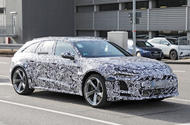Audi’s going after the AMG C63 with its own rapid PHEV estate
Audi Sport’s first plug-in hybrid will be a super-estate with an aggressive makeover and more than 440bhp
The new Audi RS5 Avant is due in 2025 as a fearsome sports estate that will kick off a move into electrification by the Audi Sport performance division.
The first plug-in hybrid from Audi Sport is a successor to today’s pure-V6 RS4 that takes a new name in line with Audi’s plan to give odd numbers to combustion cars and evens to EVs. The equivalent electric model, badged RS4 E-tron, is expected to launch by 2026.
The new RS5 Avant has now been spotted testing for the first time, with the yellow warning sticker and visible charging flap giving away its electrified innards.
While it gets a new name and a new look inside and out, Audi’s fast family wagon is set to keep its 2.9-litre V6, but with the addition of an electric motor boosting output beyond the 444bhp and 443lb ft of today’s version.
The next-generation A5 will continue to use the VW Group’s MLB platform, but with modifications to allow plug-in hybrid versions – including the RS5 – to accommodate a larger, 14.4kWh battery, which gives the current A6 PHEV an electric range of 45 miles.
Notably, the Mercedes-AMG C63 – one of the RS5’s closest rivals – has also made the switch to a plug-in hybrid powertrain and now produces a colossal 671bhp and 752lb ft to match the outright pace of its V8-engined forebear.
BMW will provide a rival in the form of the next-generation M5, which will also use a plug-in hybrid powertrain and offer an estate body for the first time since 2007.
Audi’s first take on the fast PHEV will wear its performance billing on its sleeve, with heavily flared arches and huge, five-spoke sports wheels covering large-diameter drilled brake discs.
There is also a prominent air outlet behind the front wheel arches, and the front end looks to have been sculpted with an eye on optimising engine cooling and airflow.
![]()
Saloon and Avant estate bodystyles will be offered for the standard A5, with each unlikely to grow in size compared with the current A4. For reference, it stretches to 4772mm in length, 1847mm in width and 1435mm in height. Only the estate has been spotted testing so far in full-bore RS guise, and it is not yet confirmed if Audi plans to offer a saloon version, as AMG does with the C63.
Meanwhile, volume-selling versions of the A5 will be available with a range of upgraded petrol and diesel engines with either mild-hybrid or plug-in hybrid assistance, and four-wheel drive.
Further developments for the MLB platform include a new electric architecture with 48V capability. This enables the adoption of additional functions such as the Dynamic All-Wheel Steering system used by the A6, A7, A8, Q7 and the ICE Q8, as well as new level-two autonomous driving functions currently being developed by Audi’s Car.Software division.
It also provides the base for a range of new digital and connectivity features. Among them is near-field communication functionality being developed by Audi and Huawei. This enables contactless payment for refuelling or charging, tolls, parking, drive-through dining and other services from within the car via the MyAudi app.
![]()
Autocar understands the new A5 will run an updated version of the current model’s aluminium-intensive multi-link front and rear suspension, with adaptive damping on selected models. Earlier speculation suggested the next A5 would receive rear air springs, but these may be reserved exclusively for the electric A4.
The key combustion engine for the 2023 A5 is a fifth-generation version of the Audi-developed turbocharged 2.0-litre four-cylinder EA888 petrol unit. First introduced in 2008, it is being re-engineered to meet stiff new Euro 7 emission regulations with a number of innovations, including newly developed fuel injection and particulate filter systems.
The reworked combustion engines for the A5 are set to be mated exclusively to either a seven-speed dual-clutch or eight-speed torque-converter automatic gearbox to guarantee maximum efficiency and bring emissions down as far as possible. The six-speed manual gearbox available on today’s model will be made redundant as part of plans to reduce parts complexity.
Source: Autocar
